If you’re like me and fellow Mind Control contributor/zombie aficionado MC Frontalot, you’ve not only seen Dan O’Bannon’s The Return of The Living Dead (’85), you’ve memorized every frame, you’ve melted videotapes re-watching scenes, and you’ve often wondered, if it’s not the single best movie ever made, is it the second best?
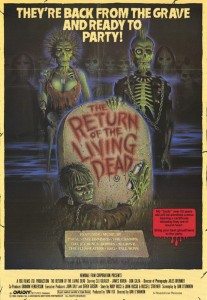 Unlike the other great zombie movies, i.e. Romero’s, there is no social commentary in The Return of The Living Dead. There is no exploration of how human societies join together or fracture in the face of zombie apocalypse. There isn’t anything, really, aside from punks and jokes and zombies eating brains. In the hands of writer/director Dan O’Bannon, this is liberating. Back in ’85, there was no “zombie genre.” You couldn’t pick which zombie TV show to watch with your parents. Jane Austen was just Jane Austen. Milking gory zombie mayhem for laughs was new, though very much in keeping with the times. The early ‘80s, beginning with An American Werewolf In London, is the golden age of horror comedies. Re-Animator, to take but one example, opened three months after The Return of The Living Dead. It was a grand time to be a weird, fourteen-year-old horror movie nerd, lemme tell ya.
Unlike the other great zombie movies, i.e. Romero’s, there is no social commentary in The Return of The Living Dead. There is no exploration of how human societies join together or fracture in the face of zombie apocalypse. There isn’t anything, really, aside from punks and jokes and zombies eating brains. In the hands of writer/director Dan O’Bannon, this is liberating. Back in ’85, there was no “zombie genre.” You couldn’t pick which zombie TV show to watch with your parents. Jane Austen was just Jane Austen. Milking gory zombie mayhem for laughs was new, though very much in keeping with the times. The early ‘80s, beginning with An American Werewolf In London, is the golden age of horror comedies. Re-Animator, to take but one example, opened three months after The Return of The Living Dead. It was a grand time to be a weird, fourteen-year-old horror movie nerd, lemme tell ya.
I mean not that zombies weren’t always a bit hilarious. Romero mined this vein to great effect in Dawn of The Dead. But no one’s going to call Dawn of The Dead a comedy. Sure, when a dumb zombie stands on a crate beneath the ‘copter blades and loses half his head, what can you do but laugh? Only then you remember that we’re the zombies. Thanks, Romero.
I saw a 35mm screening of The Return of The Living Dead at the Alamo Drafthouse’s new theater, the New Mission, last week, which must be the first time I’ve seen it projected since ’85, and it sure as hell never played on a screen as big as the New Mission’s (them days of ’85 were the era of shoebox sized multiplexes). It looks great! I recommend seeing it on film in a giant theater immediately.
And how does it play, 30 years later? Like a zombie eating your face. But, you know, in a good way. Aside from its refusal to be anything but fun, the best thing about the movie is—much to the surprise of anyone watching it for the first time—the acting. The teenage punks aren’t bad, which is itself a nice surprise. The world of cheap horror flicks is littered with the corpses of awful young actors. That these performances range from fine to good to oh-my-word-is-she-really-going-to-strip-down-and-dance-on-that-grave?-why-yes-she-is is a blessing, yes, but it’s the trio of adults that make the movie.
Clu Gulagar began his career in the ‘50s with a lot of television westerns. His best early film roles were in Don Siegel’s killer remake of the ‘40s noir flick The Killers (’64) (co-starring Ronald Reagan, by the by), and Peter Bogdanovich’s masterpiece (and one of my favorite movies), The Last Picture Show (’71). He’s kept going in TV and various movie roles ever since (he’s in last year’s Tangerine, in fact), but outside the two movies above, his finest performance is as Burt Wilson, owner of Louisville, Kentucky’s Uneeda medical supply warehouse. Fun thing I noticed seeing the movie on a big screen: in the Uneeda office there’s an eye chart on the wall that spells out: BURT IS A SLAVE DRIVER AND A CHEAP SON OF A BITCH.
Burt’s a good guy. Runs a warehouse full of medical equipment, corpses, half dogs, butterflies. The usual. When trouble shows up, he doesn’t waste a lot of time. Re-animated corpse in the meat locker? Well, you whack it in the brain, right? He’s a problem solver. Once he’s cut that corpse into tiny writhing chunks (“Get the bone saw”), it’s his idea to bring it to the mortuary and cook it in the crematorium. What could go wrong?
James Karen’s first movie appearance was in Frankenstein Meets The Space Monster (’65). It was only up from there. He appeared in All The President’s Men, The China Syndrome, Jagged Edge, Nixon, Mulholland Drive and many others. Back in the ‘80s I knew him best as the evil land developer in Poltergeist. But surely his finest role is as Frank, manager of Uneeda, a man who loves a joke and a good bullshit story. You could spend the whole movie just watching his face, he’s so expressive. When he tells the story of the mis-delivered drums of chemicals, he’s like Al Pacino in The Godfather Part II, his delivery so soft you hang on every word, waiting for the explosion. Which comes when he whacks the side of one of those drums and gets a face full of poison gas.
Late in the movie there’s a scene where Frank and new Uneeda employee Freddy (Thom Mathews), also blasted by the chemical gas, are shivering animated corpses, and my god does James Karen ever sell it. Eyes bugging out, clawed hands shaking, losing his mind—he is deep inside that role. Better yet, his ultimate sacrifice; before he becomes a brain-eater he crawls into the crematorium oven, presses the button, and cooks himself. The audience I saw it with applauded.
And, finally, Don Calfa, in movies since the ‘60s, including Scorsese’s New York, New York, Spielberg’s 1941, and Weekend At Bernie’s. His best role? Ernie the mortician. Watch his first scene, when Frank and Freddy and Burt arrive with the “rabid weasels.” Like Gulagar and Karen, his total commitment to the role sells the absurdity. Each of these guys deserved an Oscar nomination for Best Supporting Actor. Who won that year? Don Ameche for Cocoon? Who on earth has watched Cocoon since the ‘80s who isn’t related to Ron Howard? No one, that’s who. Don Ameche is great, sure. But he stole that award, goddammit! James Karen earned it, and did the Acamedy even look his way? No.
Dan O’Bannon deserves credit for casting these guys and for writing non-moronic dialogue. O’Bannon started out creating visual effects (he was tapped to work on Jodorowsky’s Dune before it collapsed), wrote John Carpenter’s first movie, Dark Star, then vaulted to fame with Alien. He wrote Blue Thunder, though it was extensively re-written much to his annoyance, and gained futher sci-fi/horror nerd-cred by writing Lifeforce (AKA Space Vampires) and Total Recall. The Return of The Living Dead was going to be directed by Tobe Hooper, but, busy directing Lifeforce, he suggested O’Bannon take over. O’Bannon tossed out the script, aside from the title, wrote his own zombie flick, and wound up with a minor masterpiece.
How can you not love a movie where the lead punk, an angry, tattooed, heavily pierced, leather-clad giant named Suicide (Mark Venturini) says of his look, “You think this is a costume? This is a way of life!”
Let us not fail to mention Linnea Quigley as Trash, whose obsession with death and dying leads logically to a nude cemetery dance number. She plays the rest of the movie naked, even when she’s eating brains. O’Bannon seems to have a thing for naked vampiric women. Lifeforce features an evil alien who’s likewise unclothed for most of the movie.
So. Come for the zombies eating brains, stay for the Oscar-worthy performances. You read it here first.

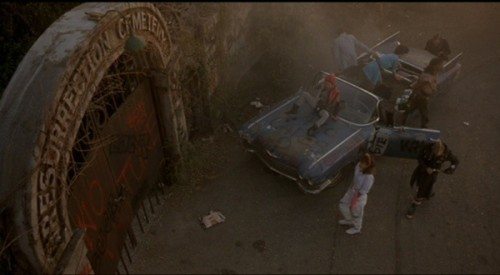
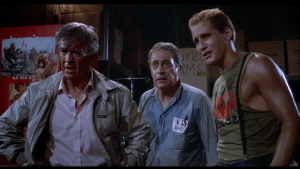
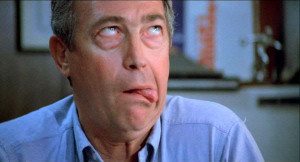
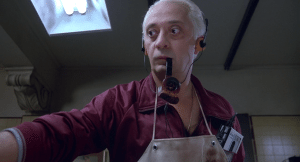
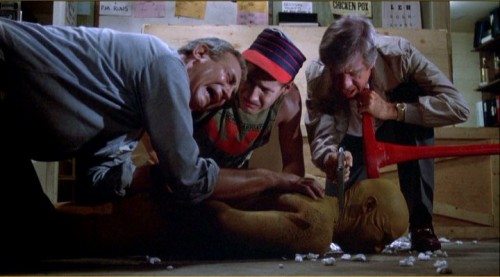
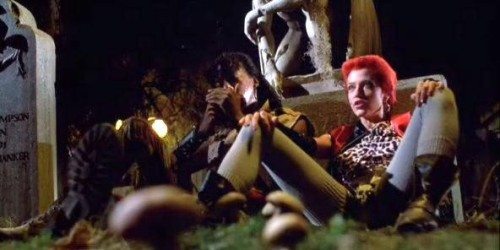
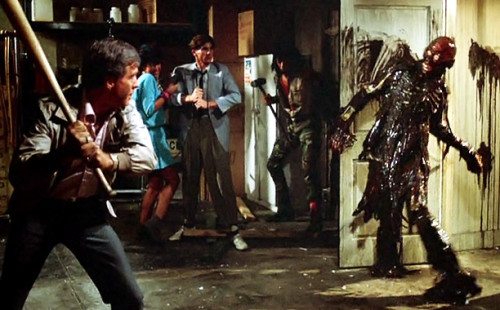
I’ve never watched this or any of the Romero movies either.
Your assignment is as follows: Night of The Living Dead, Dawn of The Dead (Romero’s, of course), The Return of The Living Dead. Enjoy!
Good times, good times.
So good. Sooo goooood. This is one my wife & I watch every few years at least. It was such a departure for the era, especially as Romero’s third Dead film went the opposite direction: too slow and too serious. I recommend this one to everyone. Not just friends, mind you, but random people on the street, in the grocery store, stopped at a red light…
I fully condone your behavior.